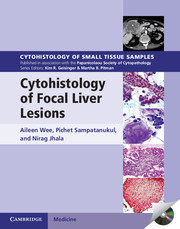Book contents
- Frontmatter
- Dedication
- Contents
- CONTRIBUTING AUTHOR
- Preface
- 1 The focal liver lesion: general considerations
- 2 Morphologic approach
- 3 Diagnostic algorithm
- 4 Focal liver lesions with low or no suspicion of malignancy
- 5 Focal liver lesions suspicious of hepatocellular carcinoma
- 6 Focal liver lesions suspicious of intrahepatic cholangiocarcinoma
- 7 Focal liver lesions from metastases and other malignancies
- 8 Focal liver lesions with cystic appearance
- 9 Focal liver lesions in infants and children
- 10 Ancillary studies
- 11 Techniques and technology in practice
- Index
10 - Ancillary studies
Published online by Cambridge University Press: 05 April 2015
- Frontmatter
- Dedication
- Contents
- CONTRIBUTING AUTHOR
- Preface
- 1 The focal liver lesion: general considerations
- 2 Morphologic approach
- 3 Diagnostic algorithm
- 4 Focal liver lesions with low or no suspicion of malignancy
- 5 Focal liver lesions suspicious of hepatocellular carcinoma
- 6 Focal liver lesions suspicious of intrahepatic cholangiocarcinoma
- 7 Focal liver lesions from metastases and other malignancies
- 8 Focal liver lesions with cystic appearance
- 9 Focal liver lesions in infants and children
- 10 Ancillary studies
- 11 Techniques and technology in practice
- Index
Summary
INTRODUCTION
While morphology trumps all ancillary studies, often these parameters fall short in providing requisite answers, particularly on smaller samples. In such cases, ancillary studies become very valuable assets in the armamentarium of pathologists. They have an adjunctive role in establishing the morphologic diagnosis of neoplastic and nonneoplastic conditions of the liver. Ancillary techniques include histochemistry, immunohistochemistry (IHC), flow cytometry, and molecular diagnostic techniques. Certain histochemical stains are of great value in the evaluation of focal liver lesions, including detection of micro-organisms. IHC is most significant in terms of clinical utility and widespread applicability. Flow cytometry is invaluable for diagnosis and classification of hematopoietic neoplasms. In these times, one should not forget that molecular studies continue to unravel information that was elusive to physicians for many years. These studies provide valuable insights for defining the molecular target for each tumor type in order to personalize therapy for a patient. Utilization of an ancillary stain or particular study, however, relies heavily upon the underlying question that one wants to answer. Thus, one should embrace an algorithmic multimodal approach by incorporating clinical information, imaging studies, and cytomorphology. This will facilitate selection of appropriate ancillary study to provide best answers.
Electron microscopy is no longer an integral part of the everyday diagnostic evaluation of liver tissue and is only utilized for certain indications. One use in particular, in the context of this book, is to help define the origin of an otherwise unrecognizable tumor. The subject is beyond the scope of this book.
HISTOCHEMISTRY (SPECIAL STAINS)
Histochemistry is perhaps one of the most commonly utilized methods in arriving at a diagnosis of focal liver lesions. It is relatively cheap, easy and rapid to perform, and utilizesthe underlying histochemical properties of a given cellular component to aid in arriving at needed information. Common histochemical stains and their diagnostic utility in the analysis of focal liver lesions are addressed.
Reticulin stains
This stain highlights reticular fibers and basement membrane material.
- Type
- Chapter
- Information
- Cytohistology of Focal Liver Lesions , pp. 250 - 272Publisher: Cambridge University PressPrint publication year: 2000



